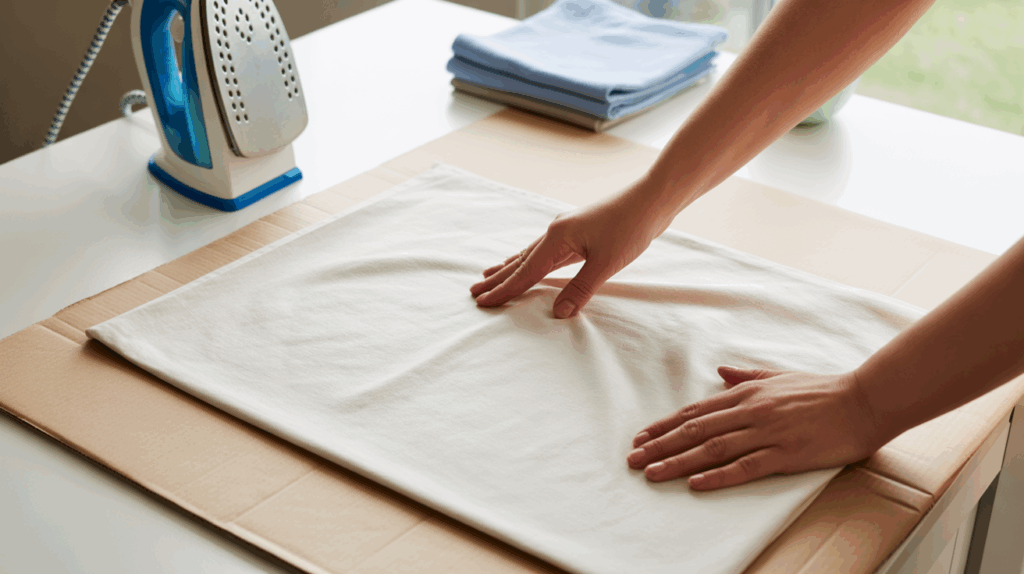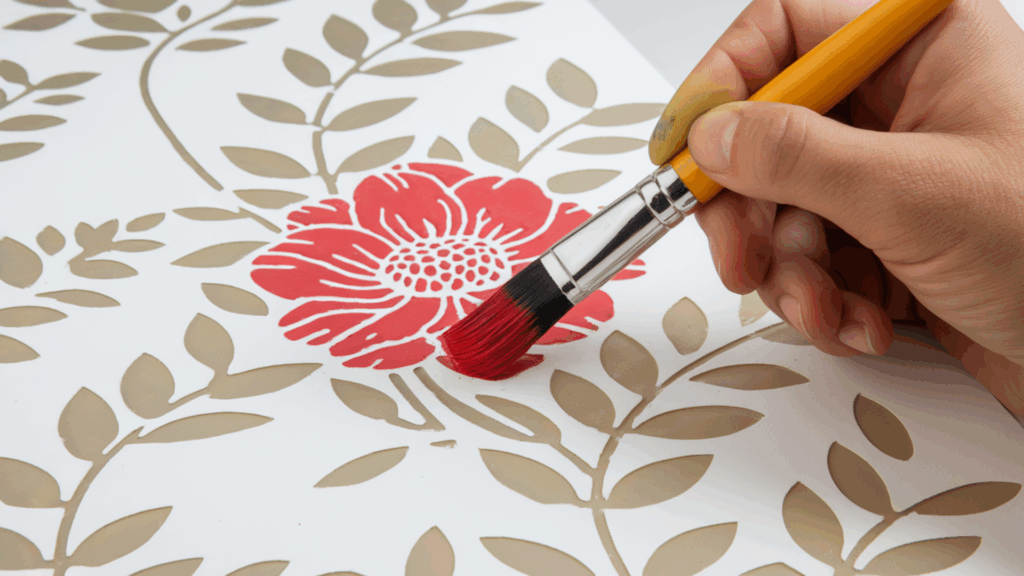Acrylic paint is loved for its bright colors and easy use. Many people enjoy painting with it on paper, wood, or canvas. But when it comes to fabric, things can get a bit challenging.
Can acrylic paint really work on fabric, and will it last after washing? These are common questions for beginners and crafters.
Using acrylic paint on fabric can give clothes, bags, and home items a fresh and creative look. With the right approach, it can turn simple fabric into art.
This article explains how to use acrylic paint on fabric, how to make it adhere, and what to keep in mind before you start.
Can You Use Acrylic Paint on Fabric?

Yes,you can use acrylic paint on fabric, but it’s not the same as fabric paint. Acrylic paint is water-based, dries quickly, and adheres well to many surfaces, including canvas, paper, and wood.
It’s made from pigment and a binder that helps it stay in place once dry, making it strong and water-resistant.
However, when used on fabric, acrylic paint alone can make the material stiff and may crack over time.
To fix this, it’s best to mix the paint with a fabric medium or follow proper methods that keep it flexible.
When done right, acrylic paint can create bright, lasting designs and turn simple items like shirts, tote bags, or pillow covers into colorful works of art.
Why Use Acrylic Paint on Fabric?
Many people prefer acrylic paint for fabric projects because it is:
- Affordable: Acrylic paints are cheaper than most fabric paints.
- Easily Available: Found in almost every art or craft store.
- Vibrant: Colors are rich and stand out on fabric.
- Versatile: Works for clothes, shoes, bags, and even home décor.
Using acrylic paint on fabric is a great way to customize and reuse old items. With some care, the paint can last a long time without fading.
Difference Between Acrylic Paint and Fabric Paint
Before using acrylic paint on fabric, it’s helpful to understand how it differs from regular fabric paint. The table below clearly shows the main differences.
| Feature | Acrylic Paint | Fabric Paint |
|---|---|---|
| Main Use | Made for canvas, paper, and wood | Made for fabric and clothing |
| Texture After Drying | Can become stiff or crack | Stays soft and flexible |
| Binder Type | Plastic-based binder | Binder designed for fabric fibers |
| Mixing Needs | Needs a fabric medium for soft results | Ready to use, no mixing needed |
| Durability on Fabric | May fade or crack if not sealed | Long-lasting and washable |
| Drying Time | Dries quickly | Dries more slowly for smoother finish |
| Cost | Usually cheaper | Slightly more expensive |
| Finish | Can be shiny or matte | Usually smooth and soft |
Steps to Use Acrylic Paint on Fabric
Painting fabric with acrylic paint is simple when you follow the right steps. With a little preparation and care, the results can look professional and last a long time.
Supplies Needed
Before starting, gather everything you need to make the process easy and mess-free.
- Acrylic paint
- Fabric medium (optional but helpful)
- Paintbrushes or sponge brushes
- Water container
- Palette or tray for mixing
- Tape or stencil (if needed)
- Cardboard or newspaper to protect surfaces
- Iron for heat-setting
- Clean fabric item (shirt, tote bag, etc.)
Step 1: Preparing the Fabric

Before painting, it’s important to properly prepare the fabric.
Wash and dry it to remove dust, oils, or other contaminants that can prevent the paint from sticking.
Iron it to remove wrinkles, then place a piece of cardboard or thick paper underneath to prevent the paint from bleeding through. A clean, flat surface gives the best results.
Step 2: Mixing Acrylic Paint with Fabric Medium

To make acrylic paint work well on fabric, mix it with a fabric medium. This helps the paint stay soft and prevents cracking.
Combine one part fabric medium with two parts acrylic paint, and stir well until smooth.
If you don’t have a fabric medium, you can still paint directly, but the fabric might feel stiff once it dries.
Step 3: Paint Fabric with Acrylic Paint

Now it’s time to paint. Lay the fabric flat on a protected surface and sketch your design lightly with a pencil or chalk.
Use thin, even layers of paint and let each layer dry before adding another.
For softer color blends, paint while the surface is still slightly wet. Thin layers help the fabric stay flexible and avoid cracking.
Step 4: Using Stencils for Better Designs

If you want clean lines or repeated patterns, stencils are a great choice.
Tape the stencil securely to the fabric, then dab paint gently with a sponge or stencil brush.
Avoid pressing too hard to prevent smudging. When finished, lift the stencil carefully to reveal a neat, even design.
Step 5: Drying and Heat-Setting the Paint

Once the painting is done, let the fabric dry completely, ideally for 24 hours. To make the paint permanent, heat-set it using an iron.
Place a thin cloth or parchment paper over the painted area, then iron on medium heat for about 3 to 5 minutes.
Keep the iron moving and avoid direct contact with the paint.
After heat-setting, some people add an extra layer of protection. You can use a clear acrylic sealer or spray fixative.
Caring for Fabric Painted with Acrylic Paint
Acrylic paint on fabric can last a long time with the right care. Gentle washing and proper handling help keep the colors bright and prevent cracks or peeling.
Below are a few simple care tips:
- Wait at least 72 hours before washing for the first time.
- Turn the fabric inside out before putting it in the washer.
- Use cold or lukewarm water instead of hot water.
- Avoid strong detergents or bleach that can fade the paint.
- Air-dry the fabric instead of using a dryer.
Following these steps will help the painted design stay soft, colorful, and long-lasting.
Is Acrylic Paint Safe for Fabric Projects?
Yes, acrylic paint is safe to use on fabric, especially after it has fully dried and been heat-set.
It’s water-based, so it doesn’t give off strong smells or harmful fumes, making it suitable for home and school projects.
For kids, adult supervision is still important since the paint can stain clothes or furniture. Acrylic paint works well on most fabrics like cotton, polyester blends, and denim, which hold color and stay flexible.
However, delicate fabrics such as silk or stretchy materials may crack when bent or stretched.
Always test a small hidden area first to ensure the paint looks good and stays durable after heat-setting.
Tips for Best Results
A few small steps can make a big difference when using acrylic paint on fabric. Follow these tips for a clean and lasting finish:
- Use thin layers: Apply light coats of paint for a smooth, even finish.
- Let each layer dry: Always wait for one layer to dry before adding the next.
- Choose soft brushes: They help prevent rough lines or brush marks.
- Paint on light fabrics: Light-colored fabrics show paint colors more clearly.
- Store properly: Keep painted items in a cool, dry place to protect the design.
These simple tips help make your fabric painting projects look neat, last longer, and stay bright.
Wrapping Up
Acrylic paint can work beautifully on fabric when used the right way. It’s safe, simple, and gives bright, lasting results on materials like cotton, polyester, and denim.
Mixing the paint with a fabric medium keeps it soft and flexible, while heat-setting helps it stay in place after washing.
Always test a small area first, as delicate or stretchy fabrics may not hold paint well. With a bit of care and patience, acrylic paint can turn plain fabric into something creative and personal.
Get your supplies ready and try it yourself, paint, heat-set, and enjoy your one-of-a-kind fabric design today!

